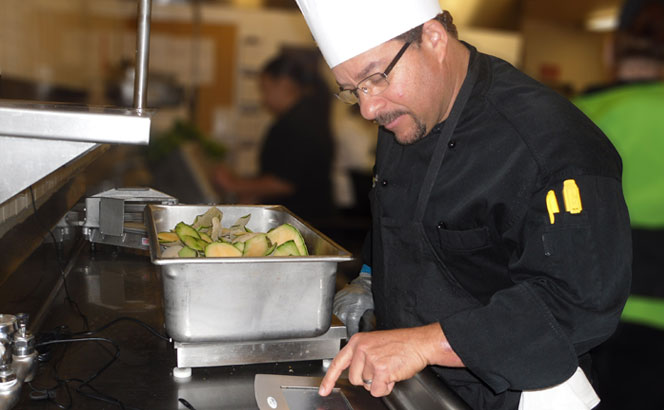
Competition in the kitchen usually involves cooking prowess, but “back of house” staff at Northern Arizona University are trying to outdo one another in a much different category: reducing food waste.
The daily quest takes on a higher level of significance now that NAU has signed on to participate in the EPA Food Recovery Challenge. The self-reporting program requires participants to measure and then set goals to reduce food waste.
“Achieving zero waste on campus is one of the most sought-after goals of campus sustainability,” said Bryan McLaren of NAU’s Office of Sustainability, citing the university’s climate action plan.
According to McLaren, it’s a goal toward which the university continues to make meaningful progress. Signing up for the EPA program was just one more way to demonstrate NAU’s commitment.
“NAU is ahead of the game,” McLaren said. “While other universities are asking basic questions about pre-consumer food composting, we’ve just reached 150,000 pounds at our compost facility.”
Much of the material that goes into compost would otherwise end up at a landfill. Instead, the compost can be used on campus and in the community while reducing waste and CO2 emissions.
About 1,000 pounds of compost can be generated each day at the Hot Spot, one of two major dining halls on campus operated by Sodexo. Food waste comes from overproduction, spoilage, expiration and trimmings. And the trimmings can pile up.
Cucumber ends, onion peels, broccoli stalks and other trimmings that result from meal preparation are weighed and tracked using equipment and software from LeanPath, a company that works with the food industry to reduce waste. The company estimates that up to $20 billion of pre-consumer waste is generated each year by restaurants and the food service industry in the United States.
At NAU, results from each week’s LeanPath data are printed and posted on a bulletin board in the kitchen—and people notice.
Cat Sullivan, sustainability specialist for NAU Campus Dining, said that “staff have really taken ownership” of the program, whether it’s some good-natured bragging about their numbers from the previous week, cutting less off the ends of cucumbers or suggestions about how to get right down to the rind of a melon.
Even a little culinary creativity comes into play.
Some of the vegetable trimmings are boiled and filtered to go into pho, a Vietnamese soup, and the stock is also used for stir fry and fried rice.
Sullivan said that amounts to more than 157 pounds each week of “vegetable trimmings that used to be discarded, and now are being used first and composted.”
Moving the positive back-of-house mentality out of the kitchen and into the food lines will be the next big step, Sullivan said. “We do a lot of educating about food waste through table tents, napkin notes and other signage. And we’re working with an educated customer,” she said of students.
McLaren, meanwhile, will aggregate numbers from LeanPath and other sources on campus to report NAU’s progress through EPA’s online Waste Wise tool. “As a starting point I think we can get close to 15 percent” of food waste diverted from landfills, he said, pointing out that with recycling, NAU could reach much higher toward its ultimate goal.
“Food recovery is our gateway to a zero waste campus,” he said.



